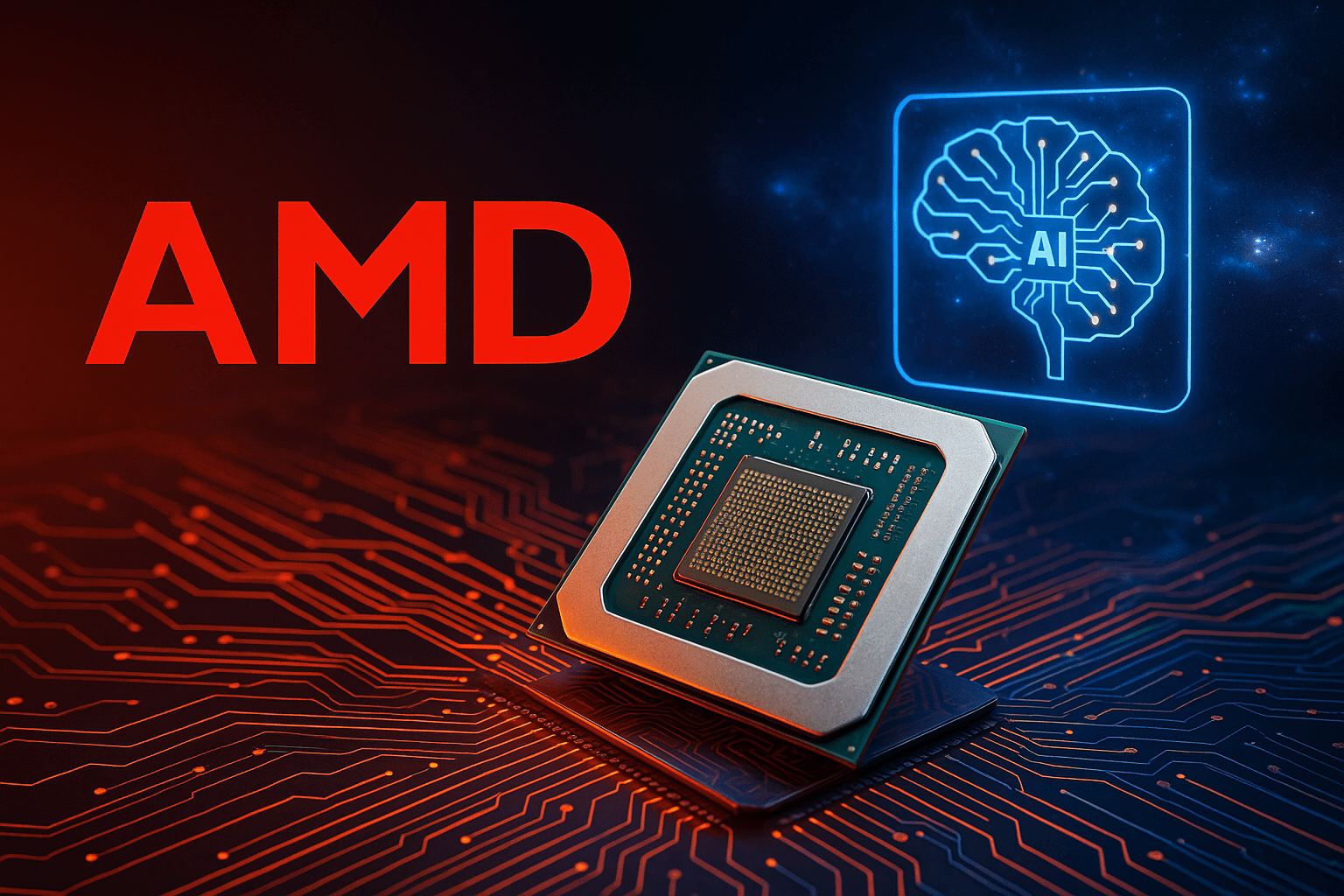Your cart is currently empty!
AMD Stock: Driving the Future of Semiconductors

Introduction
AMD stock has become a favorite among investors seeking exposure to high-performance computing, artificial intelligence (AI), and graphics processing technologies. As the demand for smarter, faster, and more energy-efficient chips grows, Advanced Micro Devices, Inc. (NASDAQ: AMD) stands at the forefront of semiconductor innovation.
Company Overview
Founded in 1969, AMD is headquartered in Santa Clara, California. Over the decades, the company has transformed from a secondary chip supplier into a primary competitor to Intel and NVIDIA. AMD designs and develops microprocessors, graphic cards (GPUs), and related technologies for consumer and enterprise markets.
The company’s most recognized product lines include:
- Ryzen processors for desktops and laptops
- Radeon graphics cards
- EPYC server chips
- Xilinx adaptive computing solutions (acquired in 2022)
AMD’s Growth Story
The resurgence of AMD began in the mid-2010s when the company launched its Zen architecture. This leap in performance and efficiency helped AMD capture market share from Intel. In recent years, AMD’s presence in data centers, cloud computing, gaming, and AI applications has driven its valuation to new heights.
AMD stock saw exponential growth from 2016 to 2022, fueled by strong quarterly earnings, strategic partnerships, and aggressive product roadmaps. The acquisition of Xilinx further strengthened AMD’s position in adaptive and embedded computing—crucial for AI and machine learning workloads.
Recent Performance and Financials
As of mid-2025, AMD holds a market capitalization of over $250 billion. The stock has shown resilience amid global supply chain disruptions and increasing competition in the AI hardware space. Recent earnings have highlighted:
- Rising demand for data center chips (EPYC series)
- Ongoing innovation in AI and edge computing
- Improved gross margins from next-gen product lines
Investors tracking AMD stock are particularly focused on quarterly revenue growth, strategic updates in AI/ML hardware development, and AMD’s response to competitive threats from Intel, NVIDIA, and Qualcomm.
AMD Stock vs. Competitors
When comparing AMD stock to peers like NVIDIA and Intel, AMD presents a balanced investment profile. While NVIDIA dominates the AI GPU space, AMD offers strong value through:
- Competitive pricing
- Cutting-edge 5nm architecture
- Diverse revenue channels (PCs, servers, consoles, embedded chips)
AI Boom and AMD’s Future
AMD is rapidly aligning itself with the AI revolution. The MI300 AI accelerator, designed to compete with NVIDIA’s H100 series, is AMD’s answer to the growing demand from hyperscalers and large AI model trainers.
Moreover, AMD is:
- Partnering with Microsoft and Meta for cloud-based AI compute
- Expanding presence in autonomous vehicles and robotics via Xilinx
- Enhancing edge processing for IoT and smart devices
All these initiatives contribute to the long-term potential of AMD stock.
Risks and Considerations
While bullish sentiment surrounds AMD, investors should consider:
- High R&D spending to keep pace with innovation
- Regulatory scrutiny of large tech mergers and acquisitions
- Macroeconomic risks affecting semiconductor demand cycles
Analyst Outlook and Investor Sentiment
Most Wall Street analysts remain optimistic on AMD stock, citing long-term revenue potential in AI, gaming, and high-performance computing. The average price target has shown a steady uptrend, supported by:
- Solid earnings beats
- Expansion into new verticals (AI inference, FPGA markets)
- Leadership under CEO Dr. Lisa Su
Technical Analysis and Chart Trends
From a technical standpoint, AMD stock often sees strong support levels around major moving averages (50-DMA and 200-DMA). Breakouts after earnings announcements or product reveals typically drive short-term rallies. Traders and long-term investors alike watch for accumulation patterns and breakout zones to enter positions.
AMD’s Role in Gaming Consoles
AMD is a vital player in the global gaming console market. Both Sony’s PlayStation and Microsoft’s Xbox are powered by custom AMD chips, integrating both CPU and GPU components. This semi-custom business model allows AMD to secure long-term contracts and build brand loyalty among gamers.
The demand for next-gen gaming experiences—4K resolution, ray tracing, and high FPS—has only strengthened AMD’s position in this segment. As gaming expands into cloud-based services, AMD’s chip efficiency and scalable architecture make it a strategic asset for platforms like Xbox Cloud Gaming and PlayStation Now.
Why Gamers and Developers Prefer AMD
- Support for DirectX 12 Ultimate
- Open-source commitment through tools like FidelityFX
- Cost-efficient high-performance GPUs
- Driver updates that cater to evolving game engines
For long-term investors, this console dominance ensures recurring revenue streams and a strong foothold in the entertainment-tech ecosystem.
AMD and the Cloud Computing Revolution
With cloud services becoming the backbone of modern enterprises, AMD’s EPYC server chips are now a key part of hyperscaler infrastructure at:
- Amazon Web Services (AWS)
- Microsoft Azure
- Google Cloud
These chips offer higher core counts, better power efficiency, and lower total cost of ownership compared to some Intel alternatives.
- Scalable across various workloads (AI, ML, analytics)
- Ideal for virtualization and container-based deployments
- Significant performance-per-dollar advantage
Key Advantages of EPYC Processors in the Cloud
This growing adoption fuels AMD stock’s bullish thesis—especially in an era when businesses are investing heavily in AI models, cloud-native apps, and edge infrastructure.
AMD’s Xilinx Acquisition and Its Strategic Importance
In 2022, AMD completed its $35 billion acquisition of Xilinx, a leader in field-programmable gate arrays (FPGAs). This deal was one of the most significant tech mergers of the decade.
Strategic Impact:
- Entry into adaptive computing—crucial for AI, robotics, and automotive sectors
- Stronger presence in 5G, aerospace, and defense industries
- Better diversification of revenue across cyclical markets
The integration of Xilinx technology enables AMD to offer customizable hardware solutions, making it more competitive in areas where flexibility and performance matter most.
Institutional Ownership and Insider Activity
A large portion of AMD stock is held by institutional investors such as:
- Vanguard Group
- BlackRock
- Fidelity
This institutional backing signals confidence in AMD’s strategic direction. Insider activity—buybacks or large executive shareholding—also reflects management’s belief in the company’s long-term value.
Tracking these metrics can give retail investors a better understanding of AMD’s support from major market participants.
AMD’s Roadmap and Product Pipeline
AMD continues to push technological boundaries with its aggressive product roadmap. Key upcoming innovations include:
- Zen 5 architecture for next-gen CPUs
- RDNA 4 graphics architecture for gaming and professional use
- MI400 AI accelerators for training large language models (LLMs)
These advancements show AMD’s commitment to staying competitive in AI, gaming, and enterprise compute.
AMD in the Context of Market Cycles
From a macro perspective, semiconductor stocks like AMD are sensitive to economic cycles. During expansion phases, demand for PCs, servers, and GPUs typically grows, lifting AMD’s revenues. In contrast, recession periods or inventory corrections may cause temporary headwinds.
However, AMD has demonstrated an ability to weather downturns better than before, owing to its:
- Diversified business model
- Long-term contracts with hyperscalers and console makers
- Growing relevance in AI and adaptive computing
Historical Stock Performance
Investors interested in AMD stock should study its historical performance patterns:
- Between 2016 and 2021, AMD rose over 3000% in market value.
- The 2022-2023 dip was largely macro-driven, not AMD-specific.
- Since mid-2024, it has rebounded strongly on AI momentum and new product launches.
Long-term charts show a trend of higher highs and higher lows, indicating sustained institutional interest and bullish sentiment.
Should You Buy AMD Stock in 2025?
For investors asking whether AMD stock is a buy in 2025, several key factors suggest it remains a strong candidate for long-term portfolios:
- Exposure to secular growth trends (AI, gaming, cloud)
- Strong leadership under CEO Dr. Lisa Su
- Healthy financials with growing free cash flow
- Cutting-edge R&D and a solid product pipeline
While short-term volatility is possible, AMD offers high upside potential for tech-focused investors with a medium-to-long-term horizon.
Astrological View (Optional Segment for RajeevPrakash.com Theme)
Astrologically, AMD stock may experience favorable transits during Mars-Jupiter or Mercury-Sun periods—favorable for innovation, growth, and technology investments. Saturn’s transit through Aquarius often boosts sectors related to electronics and AI, hinting at long-term structural gains.

Mr. Rajeev Prakash
Rajeev is a well-known astrologer based in central India who has a deep understanding of both personal and mundane astrology. His team has been closely monitoring the movements of various global financial markets, including equities, precious metals, currency pairs, yields, and treasury bonds.
